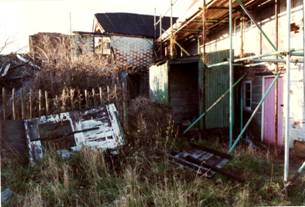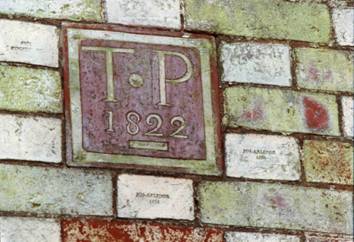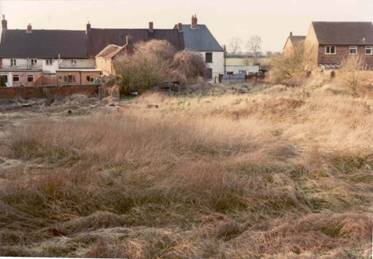Tom Patch
A New Partnership
Why he entered into an agreement with John Johnson, a local builder, is not clear. Perhaps the builder, in search of a reliable supply of materials, approached him. Perhaps Tom’s brickmaker had moved on and Tom needed some sort of partnership with John Johnson to secure the services of another. Whatever the reason, in 1821 the two men entered into an agreement by which John Johnson would have the use of the land for 10 years to make bricks and Tom would take part of the rent in bricks in order to embark on a little speculative building on his own account.18


Picture 9. The datestone was positioned on the wall of the cottage to the back of this picture
His new enterprise was commemorated with a special oversize brick, carved or stamped with the initials TP and the date 1822. (This brick was photographed, but not preserved, when the cottage into which it had been built, was demolished in 1994. It perhaps marked the cottage he had built for himself when he moved from the old family home.)

Tom no longer needed the family home – he no longer had any family. His sister Mary had died in 1799 and his mother in 1804. So he converted it into 3 smaller cottages, and his barn and wagon hovel into another 3, then he built 4 new cottages from scratch and moved into one of them himself. He was in the business of Build-to-let and one of his first tenants was his brickmaker Joseph Arlidge whose bricks were used in the new building. (The previous brickmaker may have been Robert White, but the evidence is too thin to bear any weight unless further research reveals more. On the evidence of John West’s will, Robert had moved on by 1822 at the latest).
By 1823 Tom III had developed the property his grandfather had bought for just over £60 and raised a mortgage on it for £300.19 By 1827 he’d built another 3 cottages and increased the mortgage to £350.20 A month later he raised a further £100 by a mortgage to a different lender, the details of which have not survived. Then in 1829 his first lender died and the executors called in all loans. Tom Patch found himself in debt to the tune of £465.15.06. His options were limited, his course of action constrained. He exchanged the role of landlord for that of tenant, and sold up to John Johnson for £429 two years before the termination of the brickyard agreement.21
18NRO ZB142/80/5 Agreement of 1821
19NRO ZB142/80/6 Mortgage of 1823
20NRO ZB142/80/7 Mortgage transfer of 1827
21NRO ZB142/80/9 Conveyance of 1829
